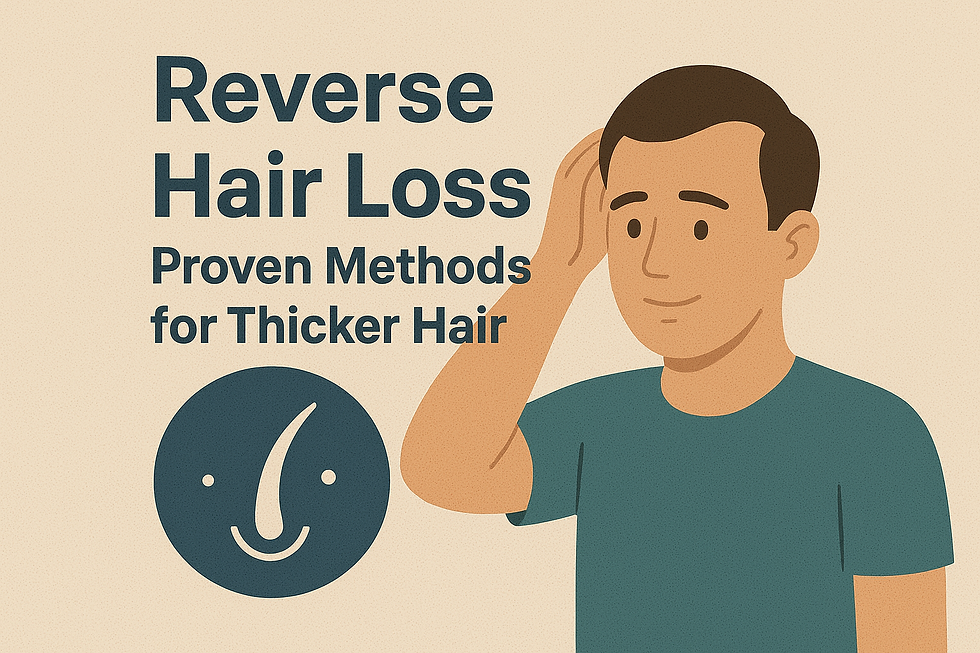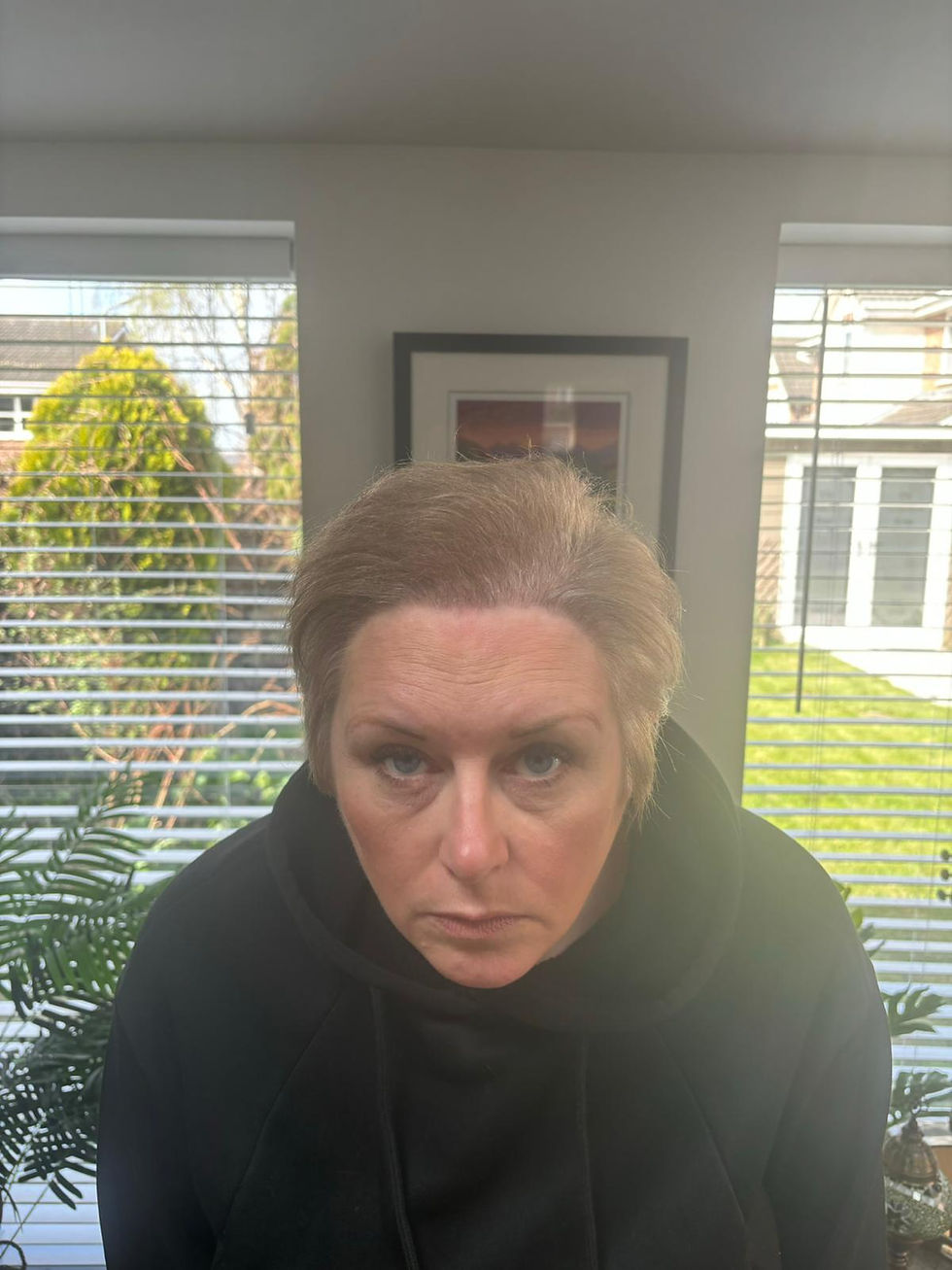Reverse Hair Loss: Proven Methods for Thicker Hair
- Vita Hair Clinic

- Sep 1, 2025
- 7 min read
Updated: Sep 3, 2025

Hair loss is a common concern that affects millions worldwide, causing distress beyond just appearance. Understanding your hair loss causes is the first step toward effective solutions. You might be wondering, can hair loss be reversed? The answer depends on several factors including the type and stage of hair loss.
Addressing hair loss early is crucial because the sooner you intervene, the better your chances of preserving and restoring healthy hair. Ignoring signs like thinning or a receding hairline can limit your options over time.
Your goals in seeking to reverse hair loss or slow its progression often focus on:
Achieving thicker hair that boosts confidence
Maintaining scalp health
Finding safe, proven hair treatment for hair loss tailored to your needs
Taking informed steps empowers you to regain control and enjoy a fuller head of hair once again.
If you're seriously considering options like a hair transplant, it's essential to understand how it works and where the hair comes from. Such procedures can significantly aid in achieving your desired results.
For personalized advice, you might want to consult with specialists such as Dr. Kinya Dusunmez who have extensive experience in this field.
Remember, it's never too late to seek help. If you're ready to take the next step towards restoring your confidence and achieving thicker hair, don't hesitate to reach out through our contact page.
Understanding Hair Loss Types and Their Causes
Hair loss, medically known as alopecia, can stem from various causes, but two of the most common types you might encounter are androgenetic alopecia and telogen effluvium.
1. Androgenetic Alopecia
Often called male or female-pattern hair loss, this type is genetic and hormone-driven. It typically leads to gradual thinning along predictable patterns—like a receding hairline in men or diffuse thinning on the crown in women. Because it’s rooted in your DNA and hormonal sensitivity, androgenetic alopecia tends to be a long-term condition.
2. Telogen Effluvium
This form usually appears suddenly and is often temporary. It occurs when significant stressors—such as illness, surgery, or emotional distress—push a large number of hair follicles into the resting (telogen) phase, causing noticeable shedding weeks or months later. Once the trigger resolves, hair growth often resumes naturally.
Understanding these differences helps you recognize whether your hair loss is likely to be temporary or influenced by genetic factors, shaping the approach for effective treatment.
Can Hair Loss Be Reversed? Exploring the Possibilities
Understanding your hair regrowth potential starts with recognizing several key factors that influence whether hair loss can be reversed:
Type of hair loss: Genetic hair loss like androgenetic alopecia tends to be progressive, making reversal more challenging. Temporary causes such as telogen effluvium often allow for full recovery once the trigger is addressed.
Duration of hair loss: The longer follicles remain dormant or miniaturized, the harder it becomes to revive them.
Health of hair follicles: Follicles that are still alive but weakened respond better to treatments than those that have completely ceased activity.
Underlying health conditions and lifestyle: Nutritional deficiencies, stress levels, and hormonal imbalances directly affect your ability to regrow hair.
Acting early plays a crucial role. Intervening at the first signs of thinning gives treatments a better chance to strengthen follicles and encourage growth before permanent damage occurs.
The window for reversing hair loss narrows as time passes and follicles deteriorate. Identifying your specific situation through professional evaluation helps tailor the best approach to maximize your hair regrowth potential.
How to Stop a Receding Hairline: Effective Strategies
The first step in treating a receding hairline is to recognize the early signs. Here's what to look for:
Gradual thinning or loss of hair around the temples.
A noticeable shift in your natural hairline shape.
Increased hair shedding when brushing or washing.
Once you notice these signs, you might find yourself wondering, "Can hair loss be reversed?" While genetics play a significant role in hair loss, there are non-surgical methods that can help you stop a receding hairline or slow its progression significantly.
Here are some practical approaches you can consider:
Topical treatments: Minoxidil is an FDA-approved option that encourages hair growth and strengthens existing follicles.
Oral medications: Finasteride targets hormone levels linked to hair loss and may reduce further recession.
Lifestyle adjustments: Managing stress, ensuring proper nutrition, and avoiding harsh hair practices support healthier hair growth.
Scalp care: Regular gentle massage and keeping the scalp clean can improve blood flow and follicle health.
If you're looking for ways to stop a receding hairline, these options may be worth exploring. Remember that everyone's needs are different, so it's important to find what works best for you. With consistent care, many people have seen noticeable results from these treatments.
Proven Treatments for Hair Loss: What Works?
When looking to reverse or slow hair loss, certain FDA-approved medications stand out for their proven effectiveness. These options target the hair follicles directly to encourage growth and reduce shedding.
1. Minoxidil
Available as a topical solution or foam, minoxidil is widely used to stimulate hair follicles and prolong the growth phase of hair. It works by improving blood flow to the scalp, making hairs thicker and stronger over time. Consistency is key—results often show after several months of daily use.
2. Finasteride
This oral medication blocks the conversion of testosterone into dihydrotestosterone (DHT), a hormone responsible for shrinking hair follicles in androgenetic alopecia. By reducing DHT levels, finasteride helps prevent further hair loss and can even promote regrowth in many men.
3. Spironolactone
Primarily prescribed for women, spironolactone acts as an anti-androgen, reducing the effects of hormones that contribute to hair thinning. It is especially effective where hormonal imbalance plays a role in hair loss.
Each medication has unique benefits and potential side effects, so discussing your individual situation with a healthcare provider ensures the safest and most effective choice tailored just for you.
In addition to these medications, there are specific conditions like a bald spot on the crown that may require targeted treatments. Understanding such conditions can help in selecting the most effective treatment options.
Advanced Therapies for Hair Restoration: Exploring the Options
When medications alone don’t deliver the desired results, advanced therapies like platelet-rich plasma (PRP) injections and low-level laser therapy (LLLT) offer promising alternatives to stimulate hair growth and improve scalp health.
Platelet-Rich Plasma Injections
PRP involves drawing a small amount of your blood, then processing it to concentrate platelets rich in growth factors. Injecting this platelet-rich plasma into the scalp helps:
Stimulate dormant hair follicles
Encourage new hair growth by enhancing cell repair
Improve blood supply to the scalp for healthier follicles
Many patients notice thicker, fuller hair after several sessions spaced weeks apart. The procedure is minimally invasive with little downtime, making it an attractive option for those seeking natural stimulation without surgery.
Low-Level Laser Therapy
LLLT uses gentle red light wavelengths aimed at the scalp to:
Boost follicle metabolism
Increase cellular energy production
Reduce inflammation that can hinder hair growth
Regular treatments can revitalize weakened follicles, slowing hair loss and encouraging thicker strands. Devices range from in-office lasers to FDA-cleared home-use caps or combs, offering flexibility based on your lifestyle.
These advanced therapies complement traditional treatments by targeting the scalp’s environment directly—helping you optimize conditions for healthier, stronger hair.
Surgical Options for Hair Loss: When Is a Transplant Necessary?
Surgical intervention, particularly the hair transplant procedure, becomes a viable option when non-surgical treatments no longer provide satisfactory results. This usually happens when hair follicles have become permanently inactive or scarred, making natural regrowth impossible.
You might consider a hair transplant if:
Hair thinning or balding has advanced despite consistent use of medications or therapies.
You seek a more immediate and lasting improvement in hair density.
Your scalp has sufficient donor hair in areas resistant to hair loss (commonly the back and sides).
A hair transplant involves relocating healthy follicles from these donor areas to balding spots, restoring natural hair growth patterns. While this doesn’t "reverse" hair loss in the traditional sense, it effectively replaces lost hair, helping you regain a fuller look.
Understanding whether your hair loss is reversible or if surgical options are necessary depends on individual factors like the type of hair loss, its progression, and response to earlier treatments. Consulting with a specialist will clarify which path suits your unique situation best.
For instance, understanding who is an ideal hair transplant candidate and hair transplant side effects could be beneficial.
Conclusion
Whether or not hair loss can be reversed largely depends on the cause and timing of treatment.
You can effectively reverse hair loss by focusing on methods that:
Maintain healthy hair follicles through proper care and early intervention
Use proven treatments tailored to your specific type of hair loss
Consider advanced therapies or surgical options when necessary
Taking action early gives you the best chance to preserve and restore your natural hair. Your journey is unique, and with the right approach, thicker, healthier hair is within reach.
FAQs (Frequently Asked Questions)
Can hair loss be reversed, and what factors influence its reversibility?
Hair loss can sometimes be reversed, especially if addressed early. Factors such as the type of hair loss, its cause, and how soon treatment begins play crucial roles in determining the potential for hair regrowth.
What are the common types of hair loss and their causes?
The most common types of hair loss include androgenetic alopecia (genetic hair loss) and telogen effluvium (temporary hair shedding). Understanding whether hair loss is genetic or temporary helps in choosing effective treatment strategies.
How can I stop a receding hairline using non-surgical methods?
Early identification of a receding hairline is key. Non-surgical strategies like topical treatments (minoxidil), oral medications (finasteride), and lifestyle changes can help halt progression and promote thicker hair growth.
What proven treatments are available for hair loss?
FDA-approved treatments such as minoxidil, finasteride, and spironolactone have shown effectiveness in slowing hair loss and stimulating regrowth. These medications work by targeting underlying causes like hormonal imbalances.
What advanced therapies exist for hair restoration?
Advanced options include platelet-rich plasma (PRP) injections, which stimulate follicle activity, and low-level laser therapy that improves follicle function. These therapies can complement traditional treatments for enhanced results.
When is a hair transplant necessary to reverse hair loss?
A hair transplant may be necessary when other treatments fail to produce desired results or when there is significant follicle loss. Surgical intervention redistributes healthy follicles to thinning areas to restore a natural-looking hairline.
Still have questions? Discover more answers in our full FAQ section













.png)
Comments